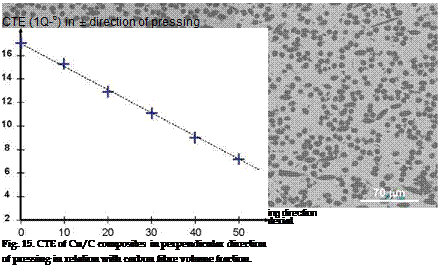The main properties of Cu/C composites depend strongly of process conditions. One of key points is the improvement of interfacial strength between copper and carbon during process. These main properties obtained by hot pressing and tape casting are discussed and presented in the following parts.
3.1 Microstructure of Cu/C composites
The final density of materials is close to 94-98 %, and no specific degradation of carbon fibres is observed in the Cu/C composites materials microstructures.
Microstructure characterization (fig. 14) shows strong anisotropy structure between the perpendicular and parallel pressing directions. Carbon fibres are oriented in perpendicular plan of pressing direction due to the strains and stresses imposed by pressing conditions and geometry. It can be expected that carbon fibre orientation leads to anisotropic properties of the Cu/C composites.
3.2 Coefficient of thermal expansion (CTE)
The CTE is measured using a differential dilatometer with a heating rate of 10°C. mn-1 from room temperature to 250°C under nitrogen to prevent t eventual oxidation of copper. Tested samples have typical size of 5 x 5 x 20 mm of length.
The CTE measured in parallel pressing direction of composite is close to 17 10-6 °C-1 (CTE of copper) for the different volume fractions of fibres. In opposite, CTE values in the perpendicular pressing direction decrease with carbon fibre volume fractions (fig. 15). Theses anisotropic properties are due to the strong anisotropy of carbon fibre properties (CTE = -1 106 °C-1 in parallel axis and 12 10-6 °C-1 in perpendicular axis) and the orientation of the fibres in the perpendicular pressing direction. It has to be noticed that CTE values parallel and perpendicular to the fibre axis have same values whatever the carbon fibre type.
 |
% carbon fibre volume fraction



